Current Status and Variation since 1964 of the Glaciers around the Ebi Lake Basin in the Warming Climate
Abstract
:1. Introduction
2. Materials and Methods
2.1. Study Area
2.2. Data
2.2.1. Remote Sensing Images
- Landsat-8 OLI remote sensing images (30 m),
- Aster remote sensing images (15 m), and
- Sentinel-2 MSI remote sensing images (10 m).
2.2.2. The 1st and 2nd CGIs Data
2.2.3. Digital Elevation Data
2.2.4. Meteorology
2.3. Methods
2.3.1. Confining Glacial Boundaries
2.3.2. Calculating Glacier Area and Volume
2.3.3. Assessing the Uncertainty
3. Results
3.1. Updated Status of Glaciers in the Ebi Lake Basin in 2019
3.2. Changes of the Glaciers Relative to the 1st and 2nd CGIs
4. Discussion
4.1. Spatial and Volume Variations of Glaciers in the Ebi Lake Basin since the 1st and 2nd CGIs
4.2. Retreat of Glaciers in the Ebi Lake Basin Compared with the Greater Tianshan Region
4.3. Factors and Their Roles in the Change of Glaciers in the Ebi Lake Basin
5. Conclusions
Author Contributions
Funding
Institutional Review Board Statement
Informed Consent Statement
Data Availability Statement
Acknowledgments
Conflicts of Interest
References
- WGII. Climate Change 2014: Impacts, Adaptation, and Vulnerability-AR5 Summary for Policymakers. WGII AR5 Phase I Rep. Launch 2014, 1, 31. [Google Scholar]
- Pritchard, H.D. Asia’s glaciers are a regionally important buffer against drought. Nature 2017, 545, 169–174. [Google Scholar] [CrossRef] [PubMed]
- Pritchard, H.D. Asia’s shrinking glaciers protect large populations from drought stress. Nature 2019, 569, 649–654. [Google Scholar] [CrossRef] [PubMed]
- Intergovernmental Panel on Climate Change. Climate Change 2013—The Physical Science Basis: Working Group I Contribution to the Fifth Assessment Report of the Intergovernmental Panel on Climate Change; Cambridge University Press: Cambridge, UK, 2014. [Google Scholar] [CrossRef] [Green Version]
- Immerzeel, W.W.; Lutz, A.F.; Andrade, M.; Bahl, A.; Biemans, H.; Bolch, T.; Hyde, S.; Brumby, S.; Davies, B.J.; Elmore, A.C.; et al. Importance and vulnerability of the world’s water towers. Nature 2019, 577, 364–369. [Google Scholar] [CrossRef] [PubMed]
- Zemp, M.; Huss, M.; Thibert, E.; Eckert, N.; McNabb, R.; Huber, J.; Barandun, M.; Machguth, H.; Nussbaumer, S.U.; Gartner-Roer, I.; et al. Global glacier mass changes and their contributions to sea-level rise from 1961 to 2016. Nature 2019, 568, 382–386. [Google Scholar] [CrossRef]
- Kraaijenbrink, P.D.A.; Bierkens, M.F.P.; Lutz, A.F.; Immerzeel, W.W. Impact of a global temperature rise of 1.5 degrees Celsius on Asia’s glaciers. Nature 2017, 549, 257–260. [Google Scholar] [CrossRef]
- Liu, S.Y.; Yao, X.J.; Guo, W.Q.; Xu, J.L.; Shangguan, D.; Wei, J.; Bao, W.; Wu, L. The contemporary glaciers in China based on the Second Chinese Glacier Inventory. Acta Geogr. Sin. 2015, 70, 3–16. [Google Scholar] [CrossRef]
- Shi, Y.; Liu, S. Pre-estimation for the response of China glaciers to global warming in the 21st century. Chin. Sci. Bull 2000, 45, 434–438. [Google Scholar] [CrossRef]
- Sun, M.; Liu, S.; Yao, X.; Guo, W.; Xu, J. Glacier changes in the Qilian Mountains in the past half-century: Based on the revised First and Second Chinese Glacier Inventory. J. Geogr. Sci. 2018, 28, 206–220. [Google Scholar] [CrossRef] [Green Version]
- Xing, W.; Li, Z.; Zhang, H.; Zhang, M.; Liang, P.; Mu, J. Spatial-temporal variation of glacier resources in Chinese Tianshan Mountains since 1959. Acta Geogr. Sin. 2017, 72, 1594–1605. [Google Scholar]
- Yao, T.; Thompson, L.; Yang, W.; Yu, W.; Gao, Y.; Guo, X.; Yang, X.; Duan, K.; Zhao, H.; Xu, B. Different glacier status with atmospheric circulations in Tibetan Plateau and surroundings. Nat. Clim. Chang. 2012, 2, 663–667. [Google Scholar] [CrossRef]
- Liu, Q.; Liu, S. Response of glacier mass balance to climate change in the Tianshan Mountains during the second half of the twentieth century. Clim. Dyn. 2015, 46, 303–316. [Google Scholar] [CrossRef]
- Zhang, Y.; Enomoto, H.; Ohata, T.; Kitabata, H.; Kadota, T.; Hirabayashi, Y. Projections of glacier change in the Altai Mountains under twenty-first century climate scenarios. Clim. Dyn. 2016, 47, 2935–2953. [Google Scholar] [CrossRef]
- Ma, L.; Wu, J.; Abuduwaili, J. Variation in aeolian environments recorded by the particle size distribution of lacustrine sediments in Ebinur Lake, northwest China. SpringerPlus 2016, 5, 481. [Google Scholar] [CrossRef] [PubMed] [Green Version]
- Wu, J.; Yu, Z.; Wang, N. Possible solar forcing of 400-year wet–dry climate cycles in northwestern China. Clim. Chang. 2009, 96, 473–482. [Google Scholar] [CrossRef]
- Tao, S.; Fang, J.; Ma, S.; Cai, Q.; Xiong, X.; Tian, D.; Zhao, X.; Fang, L.; Zhang, H.; Zhu, J.; et al. Changes in China’s lakes: Climate and human impacts. Natl. Sci. Rev. 2019, 7, 132–140. [Google Scholar] [CrossRef] [Green Version]
- NASA. Shrinking Lake Ebinur. Available online: https://earthobservatory.nasa.gov/images/84785/shrinking-lake-ebinur (accessed on 27 January 2021).
- Liu, H.; Chen, Y.; Ye, Z.; Li, Y.; Zhang, Q. Recent Lake Area Changes in Central Asia. Sci. Rep. 2019, 9, 16277. [Google Scholar] [CrossRef] [Green Version]
- Farinotti, D.; Longuevergne, L.; Moholdt, G.; Duethmann, D.; Mölg, T.; Bolch, T.; Vorogushyn, S.; Güntner, A. Substantial glacier mass loss in the Tien Shan over the past 50 years. Nat. Geosci. 2015, 8, 716–722. [Google Scholar] [CrossRef]
- Liu, S.; Ding, Y.; Zhang, Y.; Shangguan, D.; Li, J.; Han, H.; Wang, J.; Xie, C. Impact of the glacial change on water resources in the Tarim River Basin. Acta Geogr. Sin. 2006, 61, 482–490. [Google Scholar]
- Wang, P.; Li, Z.; Cao, M.; LI, H.-l. Variation of Qingbingtan glacier No. 72 in Mt. Tuomuer region during past 45 years. Sci. Geogr. Sin. 2010, 30, 962–967. [Google Scholar]
- Wang, P.; Li, Z.; Li, H.; Wu, L.; Jin, S.; Zhou, P. Changes of ice-thickness and volume for representative glaciers in Tianshan Mountains in the past 50 years. Acta Geogr. Sin. 2012, 67, 929–940. [Google Scholar]
- Wang, S.; Zhang, M.; Li, Z.; Wang, F.; Li, H.; Li, Y.; Huang, X. Response of glacier area variation to climate change in Chinese Tianshan Mountains in the past 50 years. Acta Geogr. Sin. 2011, 66, 38–46. [Google Scholar]
- Xu, J.; Liu, S.; Guo, W.; Zhang, Z.; Wei, J.; Feng, T. Glacial area changes in the Ili River catchment (Northeastern Tian Shan) in Xinjiang, China, from the 1960s to 2009. Adv. Meteorol. 2015, 2015. [Google Scholar] [CrossRef]
- Li, K.; Li, Z.; Gao, W.; Wang, L. Recent glacial retreat and its effect on water resources in eastern Xinjiang. Chin. Sci. Bull 2011, 56, 3596–3604. [Google Scholar] [CrossRef] [Green Version]
- Wang, L.; Li, Z.; Wang, F.; Edwards, R. Glacier shrinkage in the Ebinur lake basin, Tien Shan, China, during the past 40 years. J. Glaciol. 2014, 60, 245–254. [Google Scholar] [CrossRef] [Green Version]
- Zhang, H.; Li, Z.; Wang, P.; Huai, B. Variation of Haxilegen No.51 Glacier at the Headwater of Kuitun River in Tianshan Mountains and its response to climate change. Arid Zone Res. 2015, 32, 88–93. [Google Scholar]
- Abuduwailil, J.; Zhaoyong, Z.; Fengqing, J. Evaluation of the pollution and human health risks posed by heavy metals in the atmospheric dust in Ebinur Basin in Northwest China. Environ. Sci. Pollut. Res. 2015, 22, 14018–14031. [Google Scholar] [CrossRef]
- Zhang, A.; Ding, J.; Zhang, J.; Dong, Y. The variation characteristics of actual evapotranspiration in the Ebinur Lake oasis and its relationship with landscape pattern. J. Glaciol. Geocryol. 2020, 42, 1–9. [Google Scholar]
- Gorelick, N.; Hancher, M.; Dixon, M.; Ilyushchenko, S.; Thau, D.; Moore, R. Google Earth Engine: Planetary-scale geospatial analysis for everyone. Remote Sens. Environ. 2017, 202, 18–27. [Google Scholar] [CrossRef]
- Reuter, H.I.; Nelson, A.; Jarvis, A. An evaluation of void-filling interpolation methods for SRTM data. Int. J. Geogr. Inf. Sci. 2007, 21, 983–1008. [Google Scholar] [CrossRef]
- Jarvis, A.; Reuter, H.; Nelson, A.; Guevara, E. Hole-Filled Seamless SRTM Data V4: International Centre for Tropical Agriculture. Srtm. Csi. Cgiar. Org Accessed 2008, 31. [Google Scholar]
- Tsagkatakis, G.; Aidini, A.; Fotiadou, K.; Giannopoulos, M.; Pentari, A.; Tsakalides, P. Survey of Deep-Learning Approaches for Remote Sensing Observation Enhancement. Sensors (Basel) 2019, 19, 3929. [Google Scholar] [CrossRef] [PubMed] [Green Version]
- Raup, B.; Racoviteanu, A.; Khalsa, S.J.S.; Helm, C.; Armstrong, R.; Arnaud, Y. The GLIMS geospatial glacier database: A new tool for studying glacier change. Glob. Planet. Chang. 2007, 56, 101–110. [Google Scholar] [CrossRef]
- Environmental Systems Research Institute. ArcGIS Desktop: Release 10; Environmental Systems Research Institute: Redlands, CA, USA, 2011. [Google Scholar]
- Gärtner-Roer, I.; Naegeli, K.; Huss, M.; Knecht, T.; Machguth, H.; Zemp, M. A database of worldwide glacier thickness observations. Glob. Planet. Chang. 2014, 122, 330–344. [Google Scholar] [CrossRef] [Green Version]
- Moore, J.C.; Grinsted, A.; Zwinger, T.; Jevrejeva, S. Semiempirical and process-based global sea level projections. Rev. Geophys. 2013, 51, 484–522. [Google Scholar] [CrossRef]
- Ye, Q.; Kang, S.; Chen, F.; Wang, J. Monitoring glacier variations on Geladandong mountain, central Tibetan Plateau, from 1969 to 2002 using remote-sensing and GIS technologies. J. Glaciol. 2006, 52, 537–545. [Google Scholar] [CrossRef] [Green Version]
- Silverio, W.; Jaquet, J.-M. Glacial cover mapping (1987–1996) of the Cordillera Blanca (Peru) using satellite imagery. Remote Sens. Environ. 2005, 95, 342–350. [Google Scholar] [CrossRef]
- Hall, D.K.; Bayr, K.J.; Schöner, W.; Bindschadler, R.A.; Chien, J.Y. Consideration of the errors inherent in mapping historical glacier positions in Austria from the ground and space (1893–2001). Remote Sens. Environ. 2003, 86, 566–577. [Google Scholar] [CrossRef]
- Chen, J.; Ohmura, A. Estimation of Alpine glacier water resources and their change since the 1870s. IAHS Publ. 1990, 193, 127–135. [Google Scholar]
- Macheret, Y.; Cherkasov, P.; Bobrova, L. Tolschina i ob’em lednikov Djungarskogo Alatau po danniy aeroradiozondirovaniya. Mater. Glyatsiologicheskikh Issled. Khronika Obs. 1988, 62, 59–71. [Google Scholar]
- Radić, V.; Hock, R. Regional and global volumes of glaciers derived from statistical upscaling of glacier inventory data. J. Geophys. Res. Earth Surf. 2010, 115, F01010. [Google Scholar] [CrossRef]
- Shiyin, L.; Wenxin, S.; Yongping, S.; Gang, L. Glacier changes since the Little Ice Age maximum in the western Qilian Shan, northwest China, and consequences of glacier runoff for water supply. J. Glaciol. 2003, 49, 117–124. [Google Scholar] [CrossRef] [Green Version]
- Grinsted, A. An estimate of global glacier volume. Cryosphere 2013, 7, 141. [Google Scholar] [CrossRef] [Green Version]
- Huai, B.; Li, Z.; Sun, M.; Zhou, P. Glaciers change in the Tailan River watershed in the last 40 years. Sci. Geogr. Sin. 2014, 34, 229–236. [Google Scholar]
- Wang, Y.; Hou, S.; Lu, A.; LIU, Y.-p. Response of glacier variations in the eastern Tianshan Mountains to climate change, during the last 40 years. Arid Land Geogr. 2008, 31, 813–821. [Google Scholar]
- Li, B.; Zhu, A.-X.; Zhang, Y.; Pei, T.; Qin, C.; Zhou, C. Glacier change over the past four decades in the middle Chinese Tien Shan. J. Glaciol. 2006, 52, 425–432. [Google Scholar] [CrossRef] [Green Version]
- Wang, L.; Li, Z.; Wang, F.; Li, H.; Wang, P. Glacier changes from 1964 to 2004 in the Jinghe River basin, Tien Shan. Cold Reg. Sci. Technol. 2014, 102, 78–83. [Google Scholar] [CrossRef]
- Chen, J.; Liu, C.; Jin, M. Application of the repeated aerial photogrammetry to monitoring glacier variation in the drainage area of the Urumqi River. J. Glaciolgy Geocryol. 1996, 18, 331–336. [Google Scholar]
- Gao, W.; Li, Z.; Li, K.; Zhang, M.-j. Glacier variation in the Kukesu River Basin during 1963–2004 based on remote sensing data and GIS techniques. Arid Land Geogr. 2011, 34, 252–261. [Google Scholar]
- Xu, C.; Wang, F.; Li, Z.; Wang, L.; Wang, P. Glacier variation in the Manas River Basin during the period from 1972 to 2013. Arid Zone Res. 2016, 33, 628–635. [Google Scholar]
- He, Y.; Yang, T.-b.; Du, J.; TIAN, H.-z. Glacier variation of past 22 years in Alatau Mountains of Central Asia based on GIS and RS. Res. Soil Water Conserv. 2013, 20, 130–134. [Google Scholar]
- Shi, Y.S.; Shen, Y.P.; Li, D.L.; Zhang, G.W.; Ding, Y.J.; Hu, R.J.; Kang, E.S. Discussion on the present climate change from warm-dry to warm-wet in northwest China. Quaternay Sci. 2003, 23, 152–164. [Google Scholar]
- Oerlemans, J. Extracting a Climate Signal from 169 Glacier Records. Science 2005, 308, 675. [Google Scholar] [CrossRef] [PubMed] [Green Version]

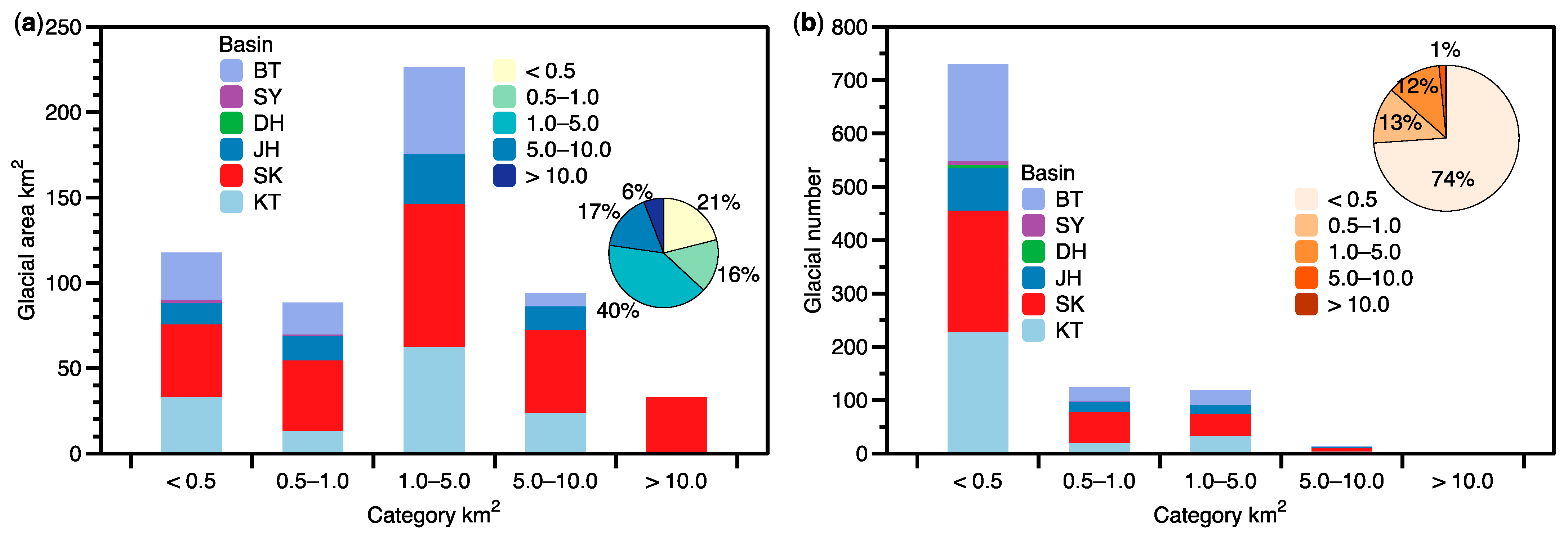
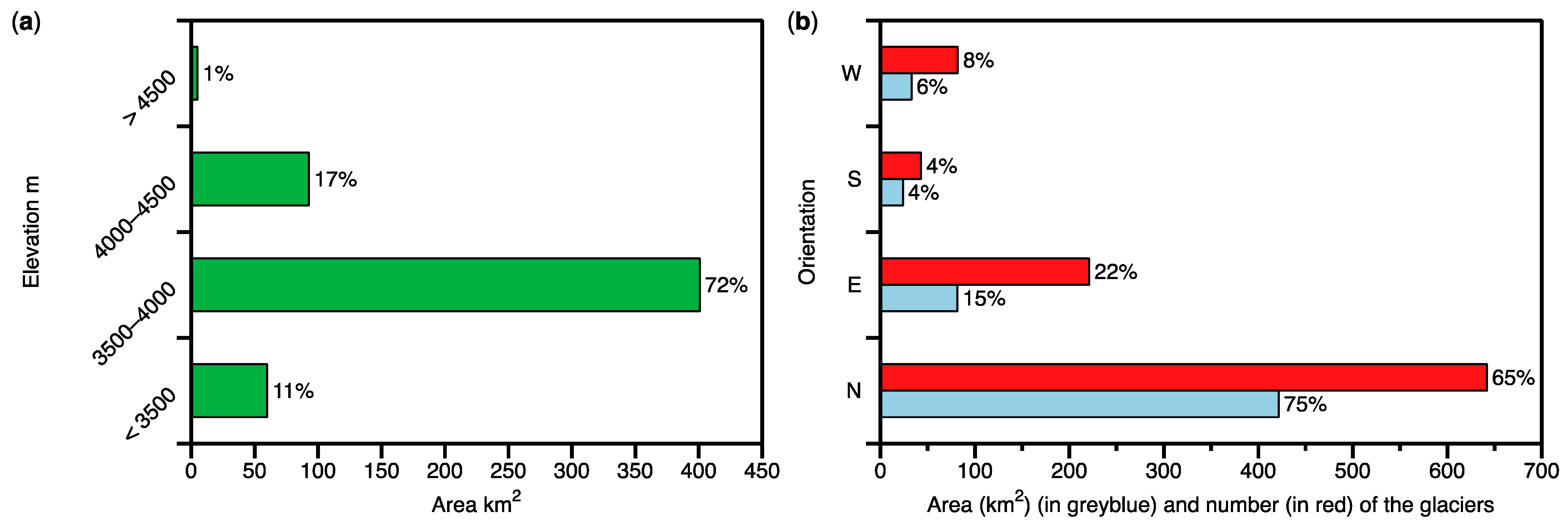
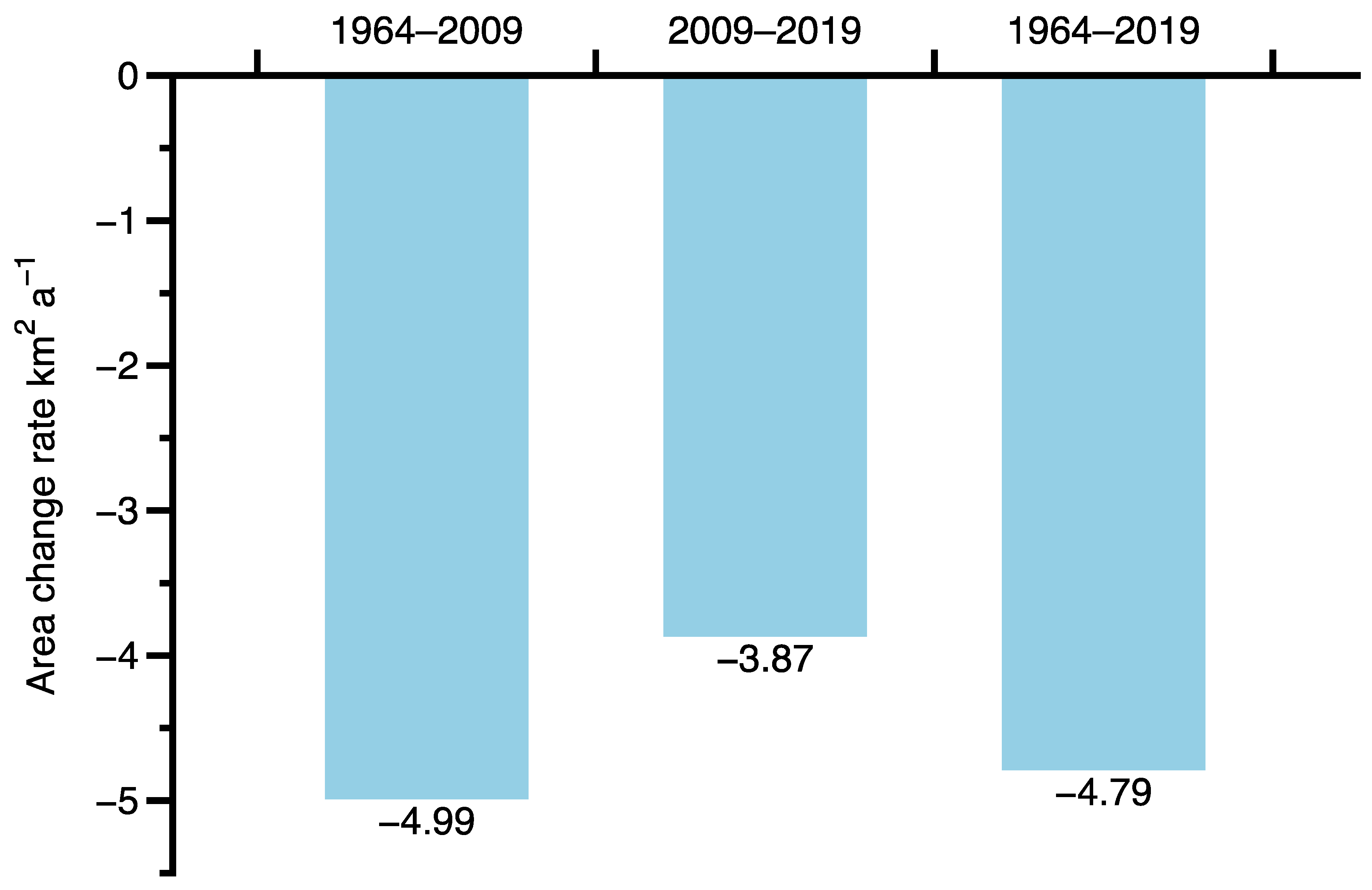
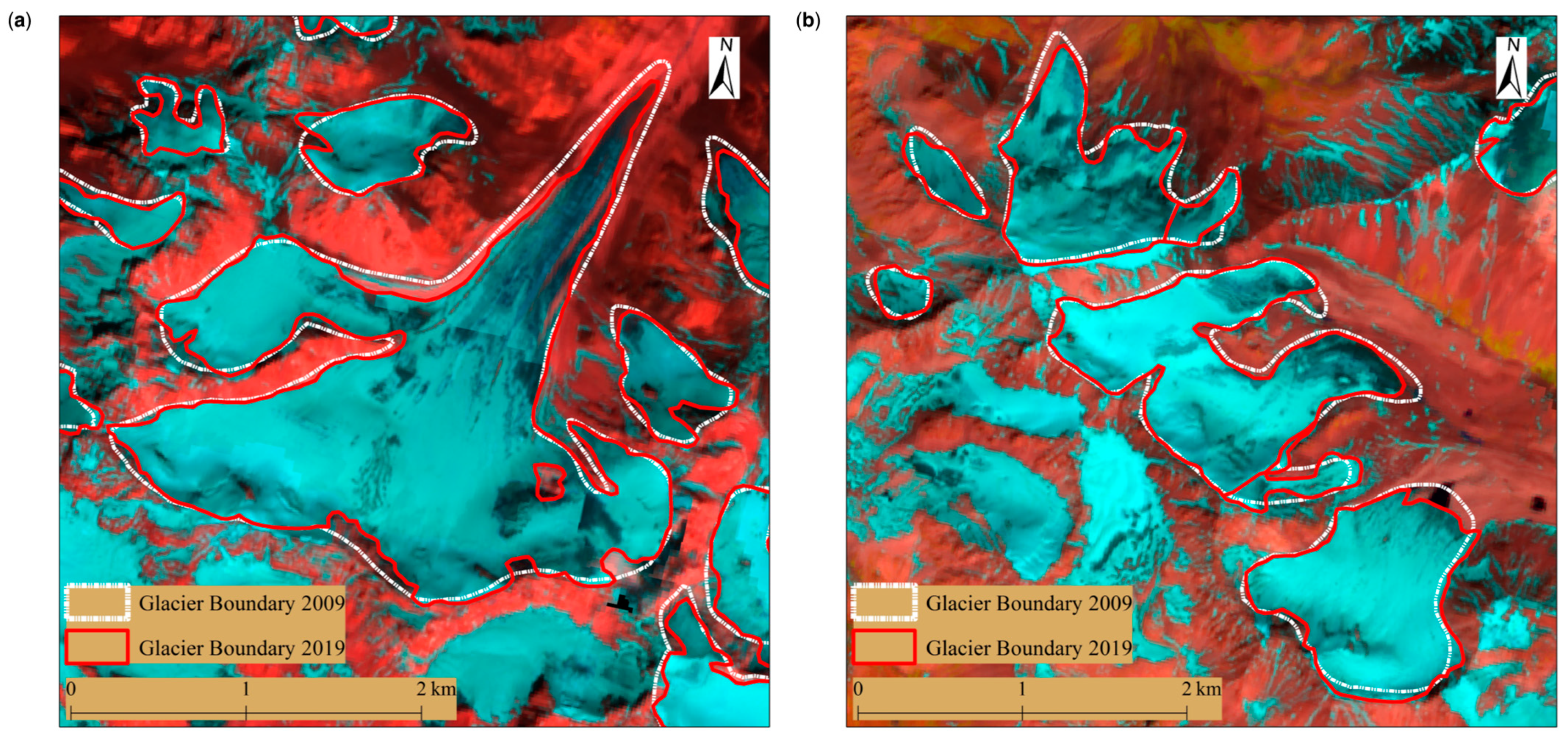
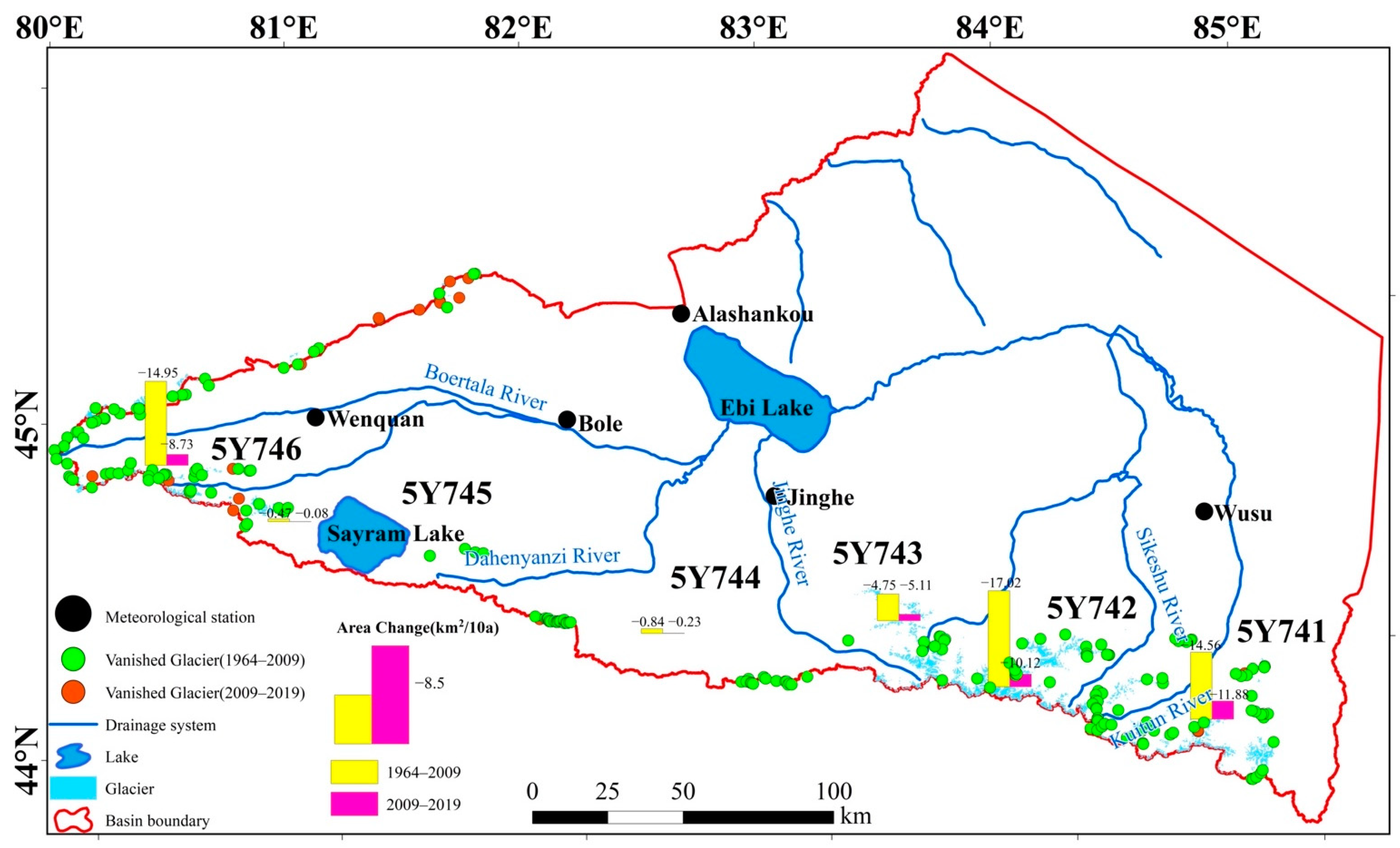
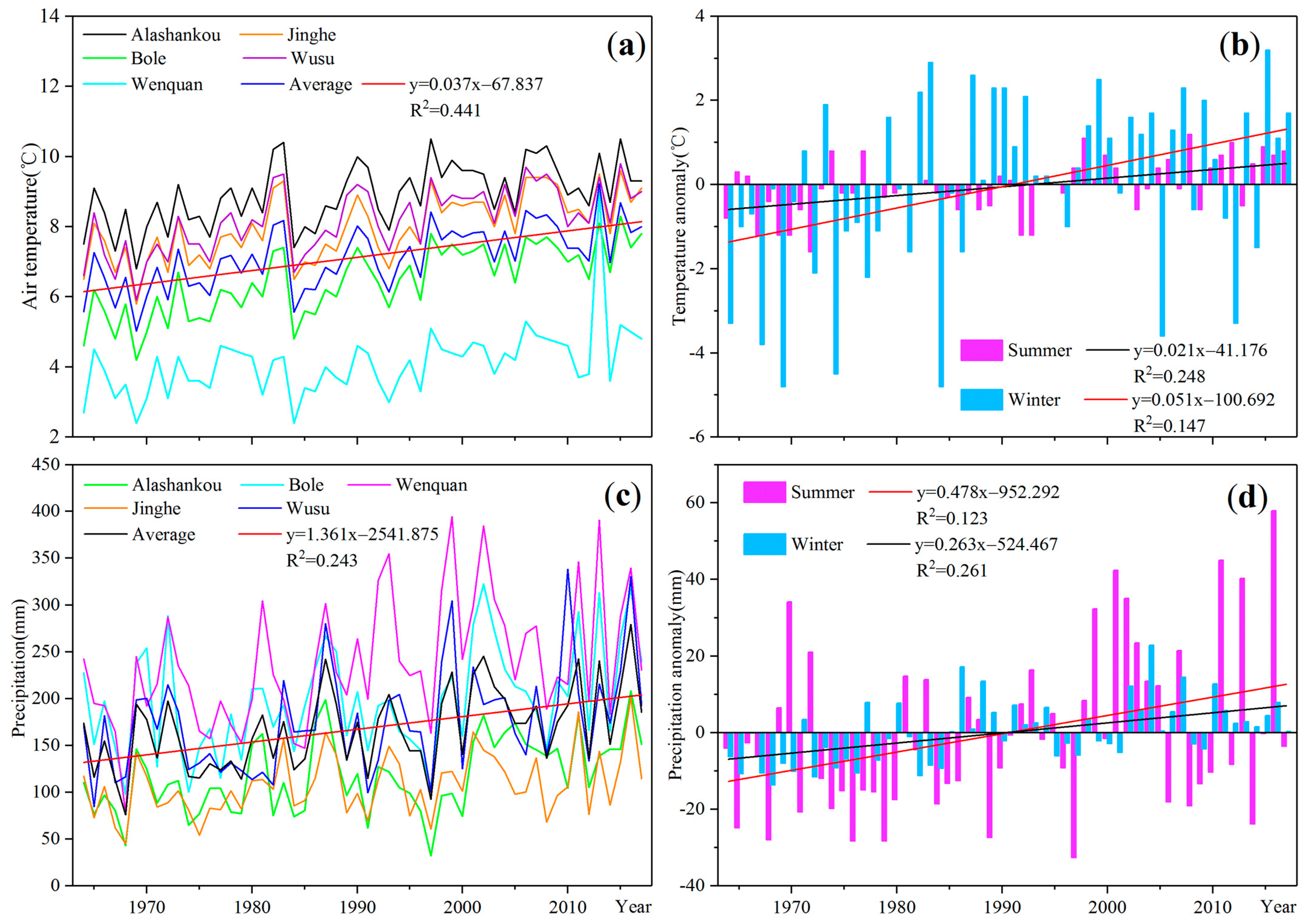
| Code by CMDS | Name | Latitude (N) | Longitude (E) | Elevation (m) |
|---|---|---|---|---|
| 51232 | Alashankou | 45°11′ | 82°35′ | 284.8 |
| 51238 | Bole | 44°54′ | 82°04′ | 531.9 |
| 51330 | Wenquan | 44°58′ | 81°01′ | 1354.6 |
| 51334 | Jinghe | 44°37′ | 82°54′ | 320.1 |
| 51346 | Wusu | 44°26′ | 84°40′ | 478.8 |
| Drainage Basin | 1st CGI (by 1964) | 2nd CGI (by 2009) | This Work (in 2019) | ||||
|---|---|---|---|---|---|---|---|
| Name | Code | Area (km2) | Number | Area (km2) | Number | Area (km2) | Number |
| Kuitun River | 5Y741 | 201.12 | 309 | 147.67 | 281 | 133.11 | 285 |
| Sikeshu River | 5Y742 | 336.25 | 364 | 259.66 | 342 | 249.54 | 337 |
| Jinghe River | 5Y743 | 96.20 | 129 | 74.81 | 118 | 69.70 | 118 |
| Daheyanzi River | 5Y744 | 4.17 | 34 | 0.38 | 7 | 0.15 | 5 |
| Sayram Lake | 5Y745 | 4.28 | 13 | 2.17 | 9 | 2.25 | 9 |
| Bortala River | 5Y746 | 181.04 | 255 | 113.75 | 243 | 105.02 | 234 |
| Ebi Lake | 5Y74 | 823.06 | 1104 | 598.44 | 1000 | 559.77 | 988 |
| Method | Ice Volume of Glaciers (km3) | Glacier Volume Change (2019s—FCGI) | Source | ||||
|---|---|---|---|---|---|---|---|
| FCGI | SCGI | 2019s | |||||
| A = 823.06 km2 | A = 598.44 km2 | A = 559.77 km2 | km3 | km3 a−1 | % a−1 | ||
| V = 0.0285 * A1.357 | 257.68 | 167.21 | 152.72 | −104.96 | −1.91 | −0.74 | [42] |
| V = 0.0298 * A1.379 | 312.32 | 201.25 | 183.54 | −128.78 | −2.34 | −0.75 | [43] |
| V = 0.0365 * A1.375 | 372.40 | 240.29 | 219.18 | −153.22 | −2.79 | −0.75 | [44] |
| V = 0.037 * A1.314 | 250.66 | 164.89 | 151.04 | −99.62 | −1.81 | −0.72 | [38] |
| V = 0.04 * A1.35 | 345.06 | 224.41 | 205.06 | −140.00 | −2.55 | −0.74 | [45] |
| V = 0.0433 * A1.29 | 249.69 | 165.52 | 151.85 | −97.84 | −1.78 | −0.71 | [46] |
| Average | 297.97 | 193.93 | 177.23 | −120.74 | −2.20 | −0.74 | This work |
| Study Area | Study Period | Area Change (km2) | Rate of Change in Area | Data | Source |
|---|---|---|---|---|---|
| Tianshan | 1960–2010 | ― | −0.22% a−1 (−11.50%) | ― | [24] |
| Tailan River Basin | 1972–2011 | −50.06 | −0.22% a−1 (−11.50%) | Topographic map, ETM+ | [47] |
| Gaizi River Basin | 1960–1999 | −188.1 | −0.26% a−1 (−10.00%) | Topographic map, TM, ETM+ | [21] |
| Harlik mountains | 1959–2001 | −13.4 | −0.27% a−1 (−11.40%) | Topographic map, TM, ETM+ | [48] |
| Kaidu River Basin | 1963–2000 | −38.5 | −0.31% a−1 (−11.60%) | Topographic map, TM, ETM+ | [21] |
| Middle Tianshan Mountains | 1963–2000 | −7 | −0.35% a−1 (−13.00%) | MSS, SPOT, ETM+ | [49] |
| Jinghe River Basin | 1964–2004 | −13.9 | −0.38% a−1 (−15.20%) | Topographic map, ASTER | [50] |
| Urumqi River Basin | 1962–1992 | −6.65 | −0.45% a−1 (−13.80%) | Topographic map, Aerial photograph | [51] |
| Kukesu River Basin | 1963–2004 | −50.06 | −0.46% a−1 (−18.99%) | Topographic map, ASTER | [52] |
| Bogda peak area | 1972–2005 | −31.2 | −0.49% a−1 (−21.60%) | Topographic map, ASTER, SPOT | [26] |
| Manas River Basin | 1972–2013 | −159.02 | −0.60% a−1 (−24.61%) | TM, ETM+ | [53] |
| Alatau Mountains | 1990–2011 | −137.77 | −0.92% a−1 (−20.24%) | TM, ETM+ | [54] |
| Ebinur Lake Basin | 1964–2019 | −263.29 | −0.58% a−1 (−31.90%) | Topographic map, Sentinel2 MSI | This study |
Publisher’s Note: MDPI stays neutral with regard to jurisdictional claims in published maps and institutional affiliations. |
© 2021 by the authors. Licensee MDPI, Basel, Switzerland. This article is an open access article distributed under the terms and conditions of the Creative Commons Attribution (CC BY) license (http://creativecommons.org/licenses/by/4.0/).
Share and Cite
Wang, L.; Bai, C.; Ming, J. Current Status and Variation since 1964 of the Glaciers around the Ebi Lake Basin in the Warming Climate. Remote Sens. 2021, 13, 497. https://doi.org/10.3390/rs13030497
Wang L, Bai C, Ming J. Current Status and Variation since 1964 of the Glaciers around the Ebi Lake Basin in the Warming Climate. Remote Sensing. 2021; 13(3):497. https://doi.org/10.3390/rs13030497
Chicago/Turabian StyleWang, Lin, Changbin Bai, and Jing Ming. 2021. "Current Status and Variation since 1964 of the Glaciers around the Ebi Lake Basin in the Warming Climate" Remote Sensing 13, no. 3: 497. https://doi.org/10.3390/rs13030497
APA StyleWang, L., Bai, C., & Ming, J. (2021). Current Status and Variation since 1964 of the Glaciers around the Ebi Lake Basin in the Warming Climate. Remote Sensing, 13(3), 497. https://doi.org/10.3390/rs13030497







